Lesson 9
THE
HISTORY
OF THE EARTH
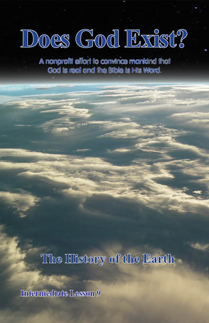 We have seen in the previous lesson that the Bible
does not give a specific date for the creation of the earth. The
Bible does give a sequence to the earth's history and it identifies
a few events which can be checked by looking into the record we find
in the fossils and rock strata of the earth's crust. A flood of
questions, both scientific and biblical, are unleashed when a
discussion of this type is initiated. (It is not the purpose of this
brief lesson to answer every question, but rather to establish some
concepts that may aid the student in his or her own study of this
subject.)
We have seen in the previous lesson that the Bible
does not give a specific date for the creation of the earth. The
Bible does give a sequence to the earth's history and it identifies
a few events which can be checked by looking into the record we find
in the fossils and rock strata of the earth's crust. A flood of
questions, both scientific and biblical, are unleashed when a
discussion of this type is initiated. (It is not the purpose of this
brief lesson to answer every question, but rather to establish some
concepts that may aid the student in his or her own study of this
subject.)
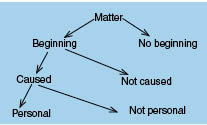 We have seen in our first
lesson that the earth had a beginning and that the beginning was
caused. In subsequent lessons we have seen that there is an
incredible amount of evidence that the cause was a personal God.
Science does not lend itself to an explanation of the creation of
matter. Science assumes matter had certain properties and had
achieved a certain level of complexity and then it provides some
possible explanations as to how it might have gone from that assumed
initial condition to the present condition. Whether science starts
at the first 10- 43 second or at some later point (both
of which have been suggested), the procedure is the same.
We have seen in our first
lesson that the earth had a beginning and that the beginning was
caused. In subsequent lessons we have seen that there is an
incredible amount of evidence that the cause was a personal God.
Science does not lend itself to an explanation of the creation of
matter. Science assumes matter had certain properties and had
achieved a certain level of complexity and then it provides some
possible explanations as to how it might have gone from that assumed
initial condition to the present condition. Whether science starts
at the first 10- 43 second or at some later point (both
of which have been suggested), the procedure is the same.
In a very similar way the Bible starts with a certain set of
conditions without explaining how those conditions were produced.
Genesis 1:1 says 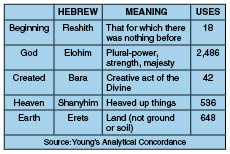 there was a
beginning and that God created (bara)
the heaven and the earth (erets
in Hebrew). If we take the Hebrew literally in this verse, we are
being told that all space, time and matter/energy in the cosmos were
created at that point. We are not told how they were created--just
that they were created. This matter/energy was formed into the
heaven and the earth. The heaven would include all celestial
objects: the sun, the moon, stars, galaxies, black holes, nebulae,
comets--everything. How long it took for this to be accomplished is
not stated in the verse. A person may complain that the sun and the
moon and the stars are described in verses 14-19, but the word used
in these verses is asah
not bara. In other words,
verses 14-19 are not saying that these objects were “created” at
that time, but that they were “made.” Verse 14 tells us why they
were made to be seen from the earth at this point in the creation
history: "Let them be for signs, and for seasons, and for days, and
years."
there was a
beginning and that God created (bara)
the heaven and the earth (erets
in Hebrew). If we take the Hebrew literally in this verse, we are
being told that all space, time and matter/energy in the cosmos were
created at that point. We are not told how they were created--just
that they were created. This matter/energy was formed into the
heaven and the earth. The heaven would include all celestial
objects: the sun, the moon, stars, galaxies, black holes, nebulae,
comets--everything. How long it took for this to be accomplished is
not stated in the verse. A person may complain that the sun and the
moon and the stars are described in verses 14-19, but the word used
in these verses is asah
not bara. In other words,
verses 14-19 are not saying that these objects were “created” at
that time, but that they were “made.” Verse 14 tells us why they
were made to be seen from the earth at this point in the creation
history: "Let them be for signs, and for seasons, and for days, and
years."
 One might theorize that
heavy cloud cover may have obscured the view of the heavens from the
earth so that one could not establish the signs, seasons, days, or
years. Now the chronometers were established in preparation for
man’s arrival.
One might theorize that
heavy cloud cover may have obscured the view of the heavens from the
earth so that one could not establish the signs, seasons, days, or
years. Now the chronometers were established in preparation for
man’s arrival.
Not only does the first verse give us the creation of celestial
objects, but of a functional earth itself. Notice that the verse
says God created the heaven and the earth. The word erets in Hebrew used in this
verse does not mean a blob of molten rock. The normal use of this
word is for a working earth. There are numerous passages where the
word erets clearly means a
functional earth such as Genesis 6:4-11 and Deuteronomy 28:23-26. By
the end of Genesis 1:1 there was a functional, living, working
earth. If you had stood upon the earth at this point in time, you
would have recognized it. Let us once again remind you that how long
God used to accomplish this creation is not revealed in the passage.
Only by making enormous assumptions can we give any approximation as
to when this creation occurred or how much 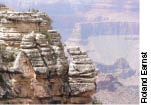 time was involved in its completion.
time was involved in its completion.
Another unknown in this verse is the method or methods God used to
accomplish His purposes. Did God create oil in the ground, coal deep
within the earth, canyons like the Grand Canyon, fossils deep inside
the earth and on the tops of high mountains? He could have done all
of this and thus given the impression that the earth was produced
over eons of time if He chose to do so. God also could have created
you two seconds ago with this booklet in your hand, the memory in
your head, and the earth functioning as it is all around you. The
question is not what God could have done, but rather what 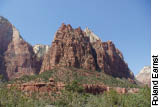 did He do. To
suggest that God created a full grown earth with fossils in the
ground, carbonized plants in coal seams, the light from distant
galaxies in place, all in an instant, raises some serious questions
about God’s nature and the promises He gives. Consider the
following: "Let no man say when he is tempted, I am tempted of God:
for God cannot be tempted with evil, neither tempteth he any man"
(James 1:13). (See also Deuteronomy 32:4; Psalms 25:8-10; 33:4-5;
Romans 3:4; Jeremiah 9:24; Lamentations 3:25; Numbers 23:19; James
1:17; Titus 1:2; Psalm 111:3; Romans 9:14; and 1 Samuel 15:29.)
did He do. To
suggest that God created a full grown earth with fossils in the
ground, carbonized plants in coal seams, the light from distant
galaxies in place, all in an instant, raises some serious questions
about God’s nature and the promises He gives. Consider the
following: "Let no man say when he is tempted, I am tempted of God:
for God cannot be tempted with evil, neither tempteth he any man"
(James 1:13). (See also Deuteronomy 32:4; Psalms 25:8-10; 33:4-5;
Romans 3:4; Jeremiah 9:24; Lamentations 3:25; Numbers 23:19; James
1:17; Titus 1:2; Psalm 111:3; Romans 9:14; and 1 Samuel 15:29.)
The Bible does not present God as a deliberately deceptive God who
purposely produces evidence that would mislead sincere, seeking
individuals. Why would God place a dried out dinosaur in a deposit
thousands of feet underground if the animal in fact never lived? The
answer is that He would not. As Einstein said, "God is subtle, but
he's not malicious."
A more logical and consistent approach to the creation is to realize
that God has made (asah)
much of what is on the earth as well as creating it! Genesis 2:3
closes the history of the earth of the first chapter by saying: "And
God blessed the seventh day, and sanctified it: because that in it
he had rested from all his work which God created and made" (emphasis added). Both processes
were involved in all of the things that God produced.
Not only was the matter created in Genesis 1:1, but that matter was
shaped and molded into a finished "heaven and earth." In order for
that to happen, some making, and forming, and shaping had to take
place. This molding and shaping is a continuous process--still in
operation in various ways today. It is very possible that a living
ecosystem operated in Genesis 1:1 to produce the earth. Bacteria may
have swarmed in the oceans and giant plants may have lived in great
swamps. Dinosaurs may have roamed freely 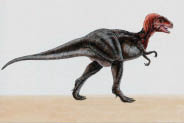 accomplishing
their purpose in being. The purpose of all of this would have been
to prepare the earth for man. This living ecosystem would have
produced the coal, oil, gas, and the like, as well as providing the
basis of man’s ultimate food supply!
accomplishing
their purpose in being. The purpose of all of this would have been
to prepare the earth for man. This living ecosystem would have
produced the coal, oil, gas, and the like, as well as providing the
basis of man’s ultimate food supply!
Of the millions of species that have lived upon the earth, the
Genesis account describes a very few. The whole history of this
planet is described in 31 short verses of Genesis 1. The Bible’s
purpose is to say that God created it all--not how or when. It is
when man speculates on the how and when, that error and conflict
creep in. We would be amiss to expect Genesis 1:1 to say "In the
beginning God synthesized deoxyribonucleic acid by the dehydration
and the polymerization of polypeptides ... ." Such an explanation
would have been total nonsense to the people of Moses' day, and to
much of the world today.
When the Genesis account does identify things we can understand, the
sequence of the creation agrees with the scientific evidence. Some
of the biblical statements are subtle and require considerable study
of the original language, while others are abundantly clear. The
structure of the water in the lithosphere, hydrosphere, and
atmosphere is implied in Genesis 1:6--7. Verses 9 and 10 imply that
the water was in one place (or bowl) and the land (erets) was in another. This
suggests that there was a single land mass and a single body of
water early in the earth’s history.
More clear is the statement that plants were present very early in
the earth’s history (before animals or man), and that three
different kinds of plants were produced (verses 10-11):
deshe--grass
(moss:
algae,
or
lichen)
(not chatsir--which is
what you mow)
eseb--herb (horsetails,
ferns, conifers)
peri--flowering tree
(apple, dogwood, etc.)
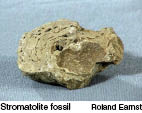 The fossil record shows that
stromatolites (picture to the right) from algae are among the first
living things upon the earth. Gymnosperms appear later
stratigraphically and include ferns, horsetails, and conifers. The
most recent plants are the angiosperms, the flowering plants which
produce seed-bearing fruit. This sequence fits the biblical
description perfectly. The kind of accuracy we have seen here
continues through Genesis 1.
The fossil record shows that
stromatolites (picture to the right) from algae are among the first
living things upon the earth. Gymnosperms appear later
stratigraphically and include ferns, horsetails, and conifers. The
most recent plants are the angiosperms, the flowering plants which
produce seed-bearing fruit. This sequence fits the biblical
description perfectly. The kind of accuracy we have seen here
continues through Genesis 1.
The first animals were water creatures (Genesis 1:20-21). The first
warm-blooded creatures were birds (verses 20-21). Later are the
mammals (verse 24), and the last thing to be created is man (verses
27-28). Much is omitted in these verses. No where do we see duckbill
platypuses, echidnas, kangaroos, insects, bats, walking or swimming
birds, and hundreds of other forms of life we are familiar with
today, but everything that is mentioned is sequentially correct.
There is an important point of biblical interpretation that needs to
be made. The word "hermeneutic" is used by scholars to describe how
we go about  interpreting the Bible.
We are suggesting a very literal and a very logical hermeneutic in
these lessons. We are suggesting that when you read a word in the
original language of the Bible, that the word in Hebrew means the
same thing every time it is used unless there is some stated reason
why that is not the case. This literalness does have some doctrinal
importance. The word "baptizo" in the Bible, for example, literally
means to immerse and in some biblical cases can be shown to have
been understood that way by the first century Christians. John was
baptizing at the Jordan because there "was much water there" (John
3:23) certainly suggests that he was immersing people. In Acts 8:38
when Philip baptized the Ethiopian Eunuch they went "down into the
water." We would suggest then, that all baptisms in the New
Testament involved immersion. That comes from the hermeneutic we
have stated. Someone may not wish to take the Bible that literally,
or may not feel that it makes any difference, but we use this
example to help you understand the words in Genesis.
interpreting the Bible.
We are suggesting a very literal and a very logical hermeneutic in
these lessons. We are suggesting that when you read a word in the
original language of the Bible, that the word in Hebrew means the
same thing every time it is used unless there is some stated reason
why that is not the case. This literalness does have some doctrinal
importance. The word "baptizo" in the Bible, for example, literally
means to immerse and in some biblical cases can be shown to have
been understood that way by the first century Christians. John was
baptizing at the Jordan because there "was much water there" (John
3:23) certainly suggests that he was immersing people. In Acts 8:38
when Philip baptized the Ethiopian Eunuch they went "down into the
water." We would suggest then, that all baptisms in the New
Testament involved immersion. That comes from the hermeneutic we
have stated. Someone may not wish to take the Bible that literally,
or may not feel that it makes any difference, but we use this
example to help you understand the words in Genesis.
In verses 24-25 the word behemah is used to describe an animal God
brings into existence. What was that animal? The word behemah is
used 52 times in the Old Testament. Forty-nine of those 52 times it
means cow. The other three times are here in Genesis 1. So what does
it mean here? Does it mean Tyrannosaurus
rex? A cow was something that could be milked. I would love
to see you try to milk a T. rex.
In Job 40:15-18 a "behemoth" is described. This is an enlarged form
of behemah. Did the ancient Israelites know an animal that fits this
description? The answer is that they did--perhaps more than one. One
animal that we know has existed is the glyptodont which was a giant
ground sloth. It had a "tail like a cedar" and a very small brain.
The bottom line here is that what is described in the creation
week of Genesis 1 are the animals that Moses was familiar
with--his cattle, sheep, goats, chickens, etc. What else would you
expect? Trying to explain an animal to Moses that he had never
seen would be unnecessary and incredibly difficult. How would you
describe a platypus, an echidna, a penguin, an amoeba, a virus, a
bat, a mole, a moray eel, a blue whale, or a dinosaur to a man who
had never seen one? We do not see dinosaurs in the biblical
record, nor would we expect to see one there. You can argue that
they existed but simply were not described. You can argue they
were elsewhere and Moses never saw one. You can also argue that
they existed in a different time period and that God used them to
prepare the earth and never intended for Moses to be concerned
with such animals.
There are many unanswered questions in the Genesis account because
of its brevity. Questions of time are the most obvious, but there
are many others. The message Genesis gives is that God created
everything, and He created man specially in His image. Much has been
left for man to learn, and science is the tool by which we learn it.
The brief biblical record is accurate in what it says. When we think
we have a conflict it is due to either our misreading and/or
misunderstanding of the biblical record, or our misreading and/or
misunderstanding of science. The one who did the creating will not
give us a contradictory record of that creation in His written
account.
© 2009, John N. Clayton
Lesson 9 cover picture: iStockphoto.com/floop
Lesson 9 Questions
Return to the Main
Page for the Intermediate Correspondence Course.
4/5/2012
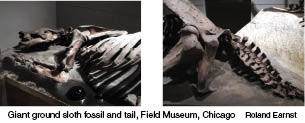
 We have seen in the previous lesson that the Bible
does not give a specific date for the creation of the earth. The
Bible does give a sequence to the earth's history and it identifies
a few events which can be checked by looking into the record we find
in the fossils and rock strata of the earth's crust. A flood of
questions, both scientific and biblical, are unleashed when a
discussion of this type is initiated. (It is not the purpose of this
brief lesson to answer every question, but rather to establish some
concepts that may aid the student in his or her own study of this
subject.)
We have seen in the previous lesson that the Bible
does not give a specific date for the creation of the earth. The
Bible does give a sequence to the earth's history and it identifies
a few events which can be checked by looking into the record we find
in the fossils and rock strata of the earth's crust. A flood of
questions, both scientific and biblical, are unleashed when a
discussion of this type is initiated. (It is not the purpose of this
brief lesson to answer every question, but rather to establish some
concepts that may aid the student in his or her own study of this
subject.) We have seen in our first
lesson that the earth had a beginning and that the beginning was
caused. In subsequent lessons we have seen that there is an
incredible amount of evidence that the cause was a personal God.
Science does not lend itself to an explanation of the creation of
matter. Science assumes matter had certain properties and had
achieved a certain level of complexity and then it provides some
possible explanations as to how it might have gone from that assumed
initial condition to the present condition. Whether science starts
at the first 10- 43 second or at some later point (both
of which have been suggested), the procedure is the same.
We have seen in our first
lesson that the earth had a beginning and that the beginning was
caused. In subsequent lessons we have seen that there is an
incredible amount of evidence that the cause was a personal God.
Science does not lend itself to an explanation of the creation of
matter. Science assumes matter had certain properties and had
achieved a certain level of complexity and then it provides some
possible explanations as to how it might have gone from that assumed
initial condition to the present condition. Whether science starts
at the first 10- 43 second or at some later point (both
of which have been suggested), the procedure is the same. there was a
beginning and that God created (bara)
the heaven and the earth (erets
in Hebrew). If we take the Hebrew literally in this verse, we are
being told that all space, time and matter/energy in the cosmos were
created at that point. We are not told how they were created--just
that they were created. This matter/energy was formed into the
heaven and the earth. The heaven would include all celestial
objects: the sun, the moon, stars, galaxies, black holes, nebulae,
comets--everything. How long it took for this to be accomplished is
not stated in the verse. A person may complain that the sun and the
moon and the stars are described in verses 14-19, but the word used
in these verses is asah
not bara. In other words,
verses 14-19 are not saying that these objects were “created” at
that time, but that they were “made.” Verse 14 tells us why they
were made to be seen from the earth at this point in the creation
history: "Let them be for signs, and for seasons, and for days, and
years."
there was a
beginning and that God created (bara)
the heaven and the earth (erets
in Hebrew). If we take the Hebrew literally in this verse, we are
being told that all space, time and matter/energy in the cosmos were
created at that point. We are not told how they were created--just
that they were created. This matter/energy was formed into the
heaven and the earth. The heaven would include all celestial
objects: the sun, the moon, stars, galaxies, black holes, nebulae,
comets--everything. How long it took for this to be accomplished is
not stated in the verse. A person may complain that the sun and the
moon and the stars are described in verses 14-19, but the word used
in these verses is asah
not bara. In other words,
verses 14-19 are not saying that these objects were “created” at
that time, but that they were “made.” Verse 14 tells us why they
were made to be seen from the earth at this point in the creation
history: "Let them be for signs, and for seasons, and for days, and
years." One might theorize that
heavy cloud cover may have obscured the view of the heavens from the
earth so that one could not establish the signs, seasons, days, or
years. Now the chronometers were established in preparation for
man’s arrival.
One might theorize that
heavy cloud cover may have obscured the view of the heavens from the
earth so that one could not establish the signs, seasons, days, or
years. Now the chronometers were established in preparation for
man’s arrival. time was involved in its completion.
time was involved in its completion. did He do. To
suggest that God created a full grown earth with fossils in the
ground, carbonized plants in coal seams, the light from distant
galaxies in place, all in an instant, raises some serious questions
about God’s nature and the promises He gives. Consider the
following: "Let no man say when he is tempted, I am tempted of God:
for God cannot be tempted with evil, neither tempteth he any man"
(James 1:13). (See also Deuteronomy 32:4; Psalms 25:8-10; 33:4-5;
Romans 3:4; Jeremiah 9:24; Lamentations 3:25; Numbers 23:19; James
1:17; Titus 1:2; Psalm 111:3; Romans 9:14; and 1 Samuel 15:29.)
did He do. To
suggest that God created a full grown earth with fossils in the
ground, carbonized plants in coal seams, the light from distant
galaxies in place, all in an instant, raises some serious questions
about God’s nature and the promises He gives. Consider the
following: "Let no man say when he is tempted, I am tempted of God:
for God cannot be tempted with evil, neither tempteth he any man"
(James 1:13). (See also Deuteronomy 32:4; Psalms 25:8-10; 33:4-5;
Romans 3:4; Jeremiah 9:24; Lamentations 3:25; Numbers 23:19; James
1:17; Titus 1:2; Psalm 111:3; Romans 9:14; and 1 Samuel 15:29.) accomplishing
their purpose in being. The purpose of all of this would have been
to prepare the earth for man. This living ecosystem would have
produced the coal, oil, gas, and the like, as well as providing the
basis of man’s ultimate food supply!
accomplishing
their purpose in being. The purpose of all of this would have been
to prepare the earth for man. This living ecosystem would have
produced the coal, oil, gas, and the like, as well as providing the
basis of man’s ultimate food supply! The fossil record shows that
stromatolites (picture to the right) from algae are among the first
living things upon the earth. Gymnosperms appear later
stratigraphically and include ferns, horsetails, and conifers. The
most recent plants are the angiosperms, the flowering plants which
produce seed-bearing fruit. This sequence fits the biblical
description perfectly. The kind of accuracy we have seen here
continues through Genesis 1.
The fossil record shows that
stromatolites (picture to the right) from algae are among the first
living things upon the earth. Gymnosperms appear later
stratigraphically and include ferns, horsetails, and conifers. The
most recent plants are the angiosperms, the flowering plants which
produce seed-bearing fruit. This sequence fits the biblical
description perfectly. The kind of accuracy we have seen here
continues through Genesis 1. interpreting the Bible.
We are suggesting a very literal and a very logical hermeneutic in
these lessons. We are suggesting that when you read a word in the
original language of the Bible, that the word in Hebrew means the
same thing every time it is used unless there is some stated reason
why that is not the case. This literalness does have some doctrinal
importance. The word "baptizo" in the Bible, for example, literally
means to immerse and in some biblical cases can be shown to have
been understood that way by the first century Christians. John was
baptizing at the Jordan because there "was much water there" (John
3:23) certainly suggests that he was immersing people. In Acts 8:38
when Philip baptized the Ethiopian Eunuch they went "down into the
water." We would suggest then, that all baptisms in the New
Testament involved immersion. That comes from the hermeneutic we
have stated. Someone may not wish to take the Bible that literally,
or may not feel that it makes any difference, but we use this
example to help you understand the words in Genesis.
interpreting the Bible.
We are suggesting a very literal and a very logical hermeneutic in
these lessons. We are suggesting that when you read a word in the
original language of the Bible, that the word in Hebrew means the
same thing every time it is used unless there is some stated reason
why that is not the case. This literalness does have some doctrinal
importance. The word "baptizo" in the Bible, for example, literally
means to immerse and in some biblical cases can be shown to have
been understood that way by the first century Christians. John was
baptizing at the Jordan because there "was much water there" (John
3:23) certainly suggests that he was immersing people. In Acts 8:38
when Philip baptized the Ethiopian Eunuch they went "down into the
water." We would suggest then, that all baptisms in the New
Testament involved immersion. That comes from the hermeneutic we
have stated. Someone may not wish to take the Bible that literally,
or may not feel that it makes any difference, but we use this
example to help you understand the words in Genesis.